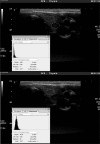Grey-Scale Analysis Improves the Ultrasonographic Evaluation of Thyroid Nodules
- PMID: 26166117
- PMCID: PMC4504637
- DOI: 10.1097/MD.0000000000001129
Grey-Scale Analysis Improves the Ultrasonographic Evaluation of Thyroid Nodules
Abstract
Ultrasonography is the main imaging method for the workup of thyroid nodules. However, interobserver agreement reported for echogenicity and echotexture is quite low. The aim of this study was to perform quantitative measurements of the degree of echogenicity and heterogeneity of thyroid nodules, to develop an objective and reproducible method to stratify these features to predict malignancy.A retrospective study of patients undergoing ultrasonography-guided fine-needle aspiration was performed in an University hospital thyroid center. From January 2010 to October 2012, 839 consecutive patients (908 nodules) underwent US-guided fine-needle aspiration. In a single ultrasound image, 3 regions of interest (ROIs) were drawn: the first including the nodule; the second including a portion of the adjacent thyroid parenchyma; the third, the strap muscle. Histogram analysis was performed, expressing the median, mean, and SD of the gray levels of the pixels comprising each region. Echogenicity was expressed as a ratio: the nodule/parenchyma, the nodule/muscle, and parenchyma/muscle median gray ratios were calculated. The heterogeneity index (HI) was calculated as the coefficient of variation of gray histogram for each of the 3 ROIs. Cytology and histology reports were recorded.Nodule/parenchyma median gray ratio was significantly lower (more hypoechoic) in nodules found to be malignant (0.45 vs 0.61; P = 0.002) and can be used as a continuous measure of hypoechogenicity (odds ratio [OR] 0.12; 95% confidence interval [CI] 0.03-0.49). Using a cutoff derived from ROC curve analysis (<0.46), it showed a substantial inter-rater agreement (k = 0.74), sensitivity of 56.7% (95% CI 37.4-74.5%), specificity of 72.0% (67.8-75.9%), positive likelihood ratio (LR) of 2.023 (1.434-2.852), and negative LR of 0.602 (0.398-0.910) in predicting malignancy (diagnostic odds ratio 3.36; 1.59-7.10). Parenchymal HI was associated with anti-thyroperoxidase positivity (OR 19.69; 3.69-105.23). The nodule HI was significantly higher in malignant nodules (0.73 vs 0.63; P = 0.03) and, if above the 0.60 cutoff, showed sensitivity of 76.7% (57.7-90.1%), specificity of 46.8% (42.3-51.4%), positive LR of 1.442 (1.164-1.786), and negative LR of 0.498 (0.259-0.960).Evaluation of nodule echogenicity and echotexture according to a numerical estimate (nodule/parenchyma median gray ratio and nodule HI) allows for an objective stratification of nodule echogenicity and internal structure.
Conflict of interest statement
The authors report no conflicts of interest.
Figures




References
-
- Chen SJ, Yu SN, Tzeng JE, et al. Characterization of the major histopathological components of thyroid nodules using sonographic textural features for clinical diagnosis and management. Ultrasound Med Biol 2009; 35:201–208. - PubMed
-
- Schiemann U, Gellner R, Riemann B, et al. Standardized grey scale ultrasonography in Graves’ disease: correlation to autoimmune activity. Eur J Endocrinol 1999; 141:332–336. - PubMed
-
- Schiemann U, Avenhaus W, Konturek JW, et al. Relationship of clinical features and laboratory parameters to thyroid echogenicity measured by standardized grey scale ultrasonography in patients with Hashimoto's thyroiditis. Med Sci Monit 2003; 9:MT13–MT17. - PubMed
-
- American Institute of Ultrasound in Medicine, American College of Radiology, Society for Pediatric Radiology, Society of Radiologists in Ultrasound AIUM practice guideline for the performance of a thyroid and parathyroid ultrasound examination. J Ultrasound Med 2013; 32:1319–1329. - PubMed
-
- Su HK, Dos Reis LL, Lupo MA, et al. Striving toward standardization of reporting of ultrasound features of thyroid nodules and lymph nodes: a multidisciplinary consensus statement. Thyroid 2014; 24:1341–1349. - PubMed
MeSH terms
LinkOut - more resources
Full Text Sources

